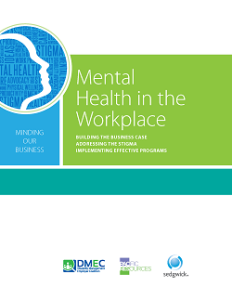On December 8, I hosted a webinar along with Donna Hardaker, former Director, Wellness Works Mental Health America of California and Heather Holladay, Integrated Health Manager Pacific Gas and Electric Company. It was a fantastic discussion on a topic which needs much more attention: stigma and social prejudice toward employees with mental health challenges. If you were not able to attend, you can revisit the recorded webinar and our presentation slides.
The statistics and research findings are compelling: Approximately 1 in 5 people is dealing with a mental health situation on a daily basis, and studies show that people with depression have a 2.5 times higher risk of on-the-job injury. [1] Mental health challenges, regardless of whether they are situational or chronic, are fraught with societal stigma, which stifles diagnosis, treatment, open dialogue and awareness of mental health and caring for those impacted.
The workplace is no different, and some argue even greater stigma occurs at work among peers and leadership, which in turn impacts absence and productivity. In fact, in 2015 the National Survey on Drug Use and Health found that just over 35% of respondents cite social concerns as reasons for not receiving mental health services, second only to cost of care at over 45%. Even more specifically, 9.5% indicate getting care might create a negative image of them in the workplace. [2]
Employers have begun to address cultures of health and well-being in a variety of ways to improve workforce and employee health, impacting health and disability costs and employee engagement and experience. Eliminating mental health stigma and social prejudice is just one step in this broader initiative. Increased education and awareness in the workplace can help eliminate labeling and misconceptions that create barriers to those seeking mental health treatment or other accommodations.
As an employer, what steps can you take as you examine your workplace culture? I offer three areas we can begin to dialogue about in today’s blog. As the year progresses, we will address these and explore even more ways we can break down the barriers.
- Integrating physical and mental well-being. Separate silos for physical and mental health are dissolving: benefits managers and risk managers alike are promoting a culture of health and tapping prevention-oriented strategies commonly available in group health plans (i.e. stress reduction, work/life balance, EAP). Education campaigns are raising awareness, and putting mental wellness on equal footing with physical health.
- Educating managers and supervisors. Organizations are training managers and supervisors to better understand mental health conditions, to identify and address behaviors that might warrant outreach, and to reduce stigma surrounding mental health needs.
- Stamping out stigma. Employees need to feel that requests for help will not be penalized and will produce real benefits. Some organizations are implementing peer advocate and peer support programs, positioning people who have successfully overcome stigma, societal predjudice and other challenges in their own lives as inspiring champions for their co-workers.
I encourage you to take the first step in understanding – download the Disability Management Employer Coalition (DMEC) “Mental health in the workplace” white paper we discussed on the webinar in December. Sedgwick partnered with DMEC and Pacific Resources to create a great resource of information to help your organization get started on its journey.

I hope part of your 2017 work resolutions will be to address this important issue and join us in our work to eliminate stigma and prejudice toward employees with mental health challenges. Think about it: what barriers and issues do you see in organizations? What ideas do you have for addressing them? Please leave me your comments, questions and suggestions, and we will try to incorporate them into a future post.
Bryon Bass, SVP, Disability and Absence Practice & Compliance